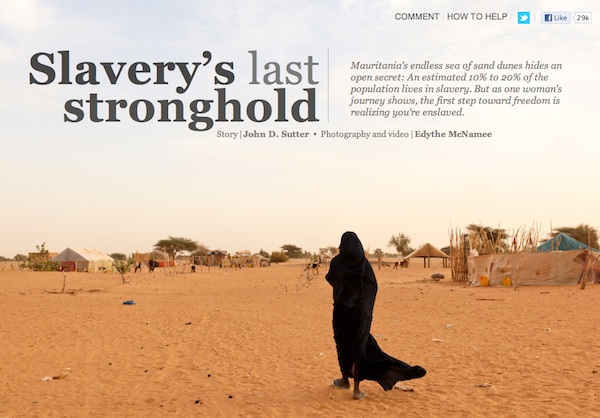

CNN’s special report Slavery’s Last Stronghold isn’t just unusual because of its topic — the remarkable fact that more than 1 in 10 residents of the west African nation of Mauritania is a slave:
An estimated 10% to 20% of Mauritania’s 3.4 million people are enslaved — in “real slavery,” according to the United Nations’ special rapporteur on contemporary forms of slavery, Gulnara Shahinian. If that’s not unbelievable enough, consider that Mauritania was the last country in the world to abolish slavery. That happened in 1981, nearly 120 years after Abraham Lincoln issued the Emancipation Proclamation in the United States. It wasn’t until five years ago, in 2007, that Mauritania passed a law that criminalized the act of owning another person. So far, only one case has been successfully prosecuted.
It’s also unusual because of its look. Breaking out of standard CNN.com templates, the story — by John D. Sutter and Edythe McNamee — is laid out more like a magazine piece: big photos, big, full-width text, type treatments, dropcaps, integrated slideshows and video, and a general design depth that indicates this isn’t just another CNN.com story.
“We knew very early on we needed to do something above and beyond our normal templates on the site,” Meredith Artley, the vice president and managing editor of CNN.com, told me. And it apparently has worked: The story’s had more than 2 million pageviews since being posted last week, Artley said.
The layout is a clear departure from most news sites, the text gets a healthy amount of breathing room, which in turn allows photos to run wide, while also incorporating maps and sidebars. For a website it feels like someone pushed the XL button (or maybe that “View in Zen Mode” button in the sidebar) — everything just feels wider, more open, and definitely a little iPad-y.
Indeed, the Apple tablet was one of the inspirations for the layout for the the piece, as were publications on the iPad like Katachi, as well as print magazines, said Marisa Gallagher, the executive creative director for CNN Digital. Gallagher said the team of designers wanted to put the focus squarely on the reading experience. She told me the design “gets rid of the competition in a lot of ways. It literally does, in that you don’t have a right rail competing for your attention.” (Also not competing for your attention: ads, of which there aren’t any on the page.)
One interesting step they took in producing the page was assembling a preliminary layout in Adobe InDesign to get a kind of physical sense of the various components of the story and how they would interact. “Sometimes you want to escape and be immersed in (a story), like a movie type experience, or you are seeking meaning so there is nothing else distracting you,” Gallagher said.
As CNN has pushed into different devices and types of reporting, they’ve tried experimenting with different types of design, Gallagher told me. But for the bulk of what is produced on CNN.com, they stick to standard news templates, ones that, while functional most of the time, don’t work for all types of storytelling. “Our article pages feel a little constricting — it’s like a little tiny world you live in and the rest of your world is full-screen,” she said.
Both Gallagher and Artley say more news sites will embrace the idea of varying design based on story types, especially as publishers play with the how stories are read on different devices.
Since CNN is active in some many places —smartphone apps, tablet apps, web, mobile web, and oh-by-the-way television — they enjoy some freedom to experiment in how they deliver their journalism, Artley said. While video remains one of CNN’s greatest strengths, Artley said series like Slavery’s Last Stronghold show the depth of investigative reporting — not to mention international reporting — at the company. That’s why she’s certain we’ll see continue to see similar projects, and non-traditional designs, in the future. “I will probably have a line of a zillion people who want to use this [template] tomorrow and I’ll have to hold them back,” Artley joked. “But we want to save this for special occasions.”